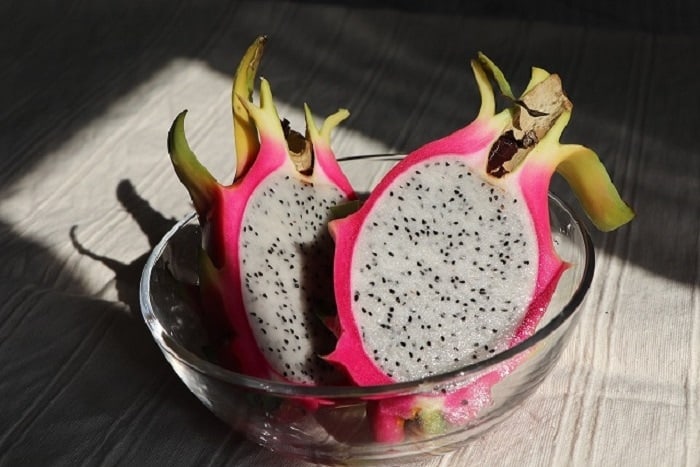Dragon fruit, pitaya, and pitahaya are among the many names of the rich, fleshy fruit that stem from several species of cacti. Yes, cacti!
Though it may seem novel to the English-speaking world, once thoroughly de-spiked the delectable dragon fruit is enjoyed by many cultures. It is now commonly cultivated in South-East Asia, at great expense.
But how long does a dragon fruit last? As such dear produce, the last thing we want is to see this unique treat going to waste. You’ll want to know when it’s ripe, and when it’s perhaps time to dispose of it.
So, how to tell if a dragon fruit is bad? Well, there are some tell-tale signs on its scale-like skin (which is where the name dragon fruit comes from, by the way). But we’ll also be teaching you how to tell if a dragon fruit is bad inside. We hope to leave you absolutely sure as to whether this dragon’s destiny is in your mouth, or in your trash.
Table Of Contents:
How To Tell If a Dragon Fruit Is Bad

To get to the root of this, we’ll have to discuss decomposition. It may be gross, but it’s a natural fact of life. If we can understand how it works, it can help us to tell if any foods (not just dragon fruit) are teetering past their best, and towards the realm of digestive danger. Here are three ways in which you can check whether a dragon fruit is safe to eat.
Three Ways to Check That a Dragon Fruit Is Good To Eat
1. Assess the skin
In perfect ripeness, the common variety of dragon fruit has a skin that is a brilliant pink with light green or yellow fronds coming off of its scales. You’ll know that your dragon fruit is starting to turn when these colors become darker, and the fronds begin to blacken and wither.
The same goes for yellow dragon fruits. They typically have shorter scales, and instead of fronds, little bumps where their spikes have been snipped off. When perfectly ripe the skin should resemble a miniature pineapple, and have the brilliant color of a lemon.
2. Give it a sniff!
We don’t just assess whether something’s good to eat with our eyes. Our sense of smell has evolved to pick up at least 1 trillion different odors. 1 trillion. That’s nine zeroes!
But even with that astonishing number of unique scents, to our human nostrils, a dragon fruit doesn’t really smell of anything. It should have a mild sweetness at best.
Any strong odors, particularly those that are sour, are an indication that your dragon fruit is well past its best and should be discarded.
3. Open it up
You might have opened it up to be completely sure. This is likely no big deal: dragon fruits are typically eaten on their own anyway (or turned into delicious smoothies with a juicer). The inedible skin, while pretty, is discarded.
Here’s how to tell if a dragon fruit is bad inside.
Dragon fruits with white insides have gone bad when the flesh has started to blacken. It may have adopted a dark-yellow tinge, and translucent veins may have started to appear on its surface. Check for any strong odors. Remember, it should have a mildly sweet smell at most.
With a dragon fruit that has a magenta or pink-tinged inside, it can be harder to tell. Do the sniff test, look for lumps of mold, and produce the flesh with your finger. If there’s a slight pressure, it’s ripe. If it feels hard or gummy, consider discarding it.
back to menu ↑
What Are The Black Dots In Dragon Fruit?
But what are those ever-present black dots that give dragon fruit its interesting look and texture? Are they safe to eat? Absolutely. They’re seeds!
All fruits contain seeds. From a botanical standpoint, they’re defined by this characteristic. This is why the tomato is actually considered a fruit and not a vegetable.
And that means that cucumbers and zucchinis/courgettes, though savory, are also fruits as well. In fact, they’re related to melons! Cucumbers and Watermelons share that soft, watery interior (although the latter is far harder to cut into).
But why do they contain seeds in the first place? Not everyone’s a fan of their gritty texture. Over time we’ve selectively bred fruits to have smaller and smaller seeds.
From the plant’s perspective: the seeds are the whole point. The fruit is deliberately vibrant and delicious and this encourages animals, including us, to eat it. We’ll then spread the indigestible seeds across our environment to grow into new plants. Some seeds in nature are digestible, but we call them beans.
back to menu ↑
Can You Eat Dragon Fruit With Mold On The Skin?
No. Although the skin is tough and seemingly protective, mold on the skin indicates that a harmful fungus has likely entered the plant. This could have happened in a litany of ways throughout picking, packaging, and travel. The result is the same. Don’t try to cut around it, discard the whole thing.
You might think that as with some fruits and vegetables, you can get away with simply cutting around the infected area. For fruits with high water content, such as the fleshy dragon fruit, it’s not worth the risk.
Some foods, such as aged cheeses, encourage the growth of mold for flavor. This is a specific type of mold that does not produce the mycotoxins that are harmful to humans. Mold on dragon fruits? Harmful. Once again, discard the whole thing.
back to menu ↑
Why Does Dragon Fruit Go Modly?
Foods naturally decompose due to micro-organisms in the air. Most bacteria grow fastest at a range of 41 – 135◦F (5 – 57◦C). This is why refrigeration helps foods keep for longer, and freezing is better still. Fungi, such as mold, can also germinate at a wide range of temperatures, but not below freezing.
Fruits start to decompose well before they are plucked from the plant. The cuticle (the fruit’s outer layer) helps to protect its nutritious interior from the environment and all kinds of would-be invaders.
If you’ve ever walked through an apple orchard, you’ll notice that the fruits on the ground are bruised and moldy while the ones on the trees look ready to eat. This is because they’re right in the path of insects and other small animals. They burrow into the fruit allowing microorganisms in the air to reach their softer, moister interiors.
Bacteria and fungi also love water. The often wetter conditions on the ground help to make a perfect match. Even despite the dragon fruit’s tough, scaly skin and formidable spines, it is still susceptible to this kind of microbial growth.
back to menu ↑
What Happens if You Eat Bad Dragon Fruit?
Mold, a fungus, is likely the thing that’ll make you sick after eating gone-off dragon fruit. It has a completely different effect on our bodies than bacteria like salmonella or trichinosis, instead targeting the respiratory system.
It’s not 100% certain that you’ll become ill after eating moldy dragon fruit, as your stomach will eliminate most of the fungal spores that produce dangerous mycotoxins.
Of course, the more mold you eat, the higher the risk. You should absolutely go to the emergency room if you begin to develop symptoms like coughing and shortness of breath in the days after eating.
back to menu ↑
How Common Is Dragon Fruit Allergy?
Dragon fruit allergy is extremely rare. There have been studies that have shown that the consumption of dragon fruit can lead to an anaphylactic reaction.
If you’ve experienced vomiting, a swollen tongue, hives on your face or body, or a painful tingling on the roof of the mouth immediately after consumption, you may be allergic. It’s best to avoid them.
What Is The Life Of A Dragon Fruit?
So, how long does a dragon fruit last? Dragon fruit will last for a few days after it has made its potentially global journey into your kitchen. Make sure that the skin hasn’t been cut into or pierced at all. Remember, that cuticle keeps the mold at bay for longer.
Unsliced, it’ll keep for up to two weeks if placed in the fridge. Keep it in a sealed container to limit the amount of moisture and oxygen it’s exposed to.
Can you Eat Overripe Dragon Fruit?
You can absolutely eat overripe dragon fruit, although you won’t get the ideal texture. Just make sure that it has passed all the checks listed above.
To quickly go through them again: a withered exterior, a sour smell, patches of mold or darkening flesh. If it has any of these, discard it.
Why is my Dragon Fruit Grey Inside?
If your dragon fruit is grey inside, this is again a sign that it is past its best. It’s going grey because the flesh of the fruit is being consumed by microorganisms and is decomposing. Don’t eat it.
Is Red or Yellow Fruit Better?

Unlike say a bell pepper, where the taste is uniform despite its color, dragon fruits do have a slight difference in taste depending on their variety. This is because they come from a range of different cacti species.
Red dragon fruits typically have a milder taste and smaller seeds than their yellow counterparts. So if you’re looking for sweetness, go yellow.
If you want a creamier texture, take the red option.
Which one is better? We’ll leave that entirely to your taste buds.
back to menu ↑
What Are The Best Ways To Store Dragon Fruit?
Like so many fresh foods, the best way to store dragon fruit is in the cold climate of the fridge. You’ll also want to will limit its exposure to air and moisture.
1. Refrigerate in a Zip-Lock Bag
This is best if you have a whole dragon fruit. Its marvelously unwieldy shape is better equipped for the malleable plastic of a zip lock bag than say, a small plastic container. Just make sure it is sealed before it goes into the fridge.
2. Refrigerate in a Sealed Container
You can, however, store dragon fruit in a sealed container by dividing it into sections first. This is perfect if you’re looking to use it incrementally in salads and smoothies. Bear in mind it won’t last as long.
Can you Freeze Dragon Fruit?
You can freeze dragon fruit, but it’s advised that you first cut the flesh into small chunks before placing it into a sealed container. This will make sure that they freeze all the way through. It will, however, result in a diminished texture over time. It will last around three months.
back to menu ↑
The Final Words
That’s absolutely everything you need to know about how to tell if a dragon fruit is bad. We’ve covered storage, taste, and even a little biology and botany too. Are you looking to try this fleshy, mildly sweet delicacy? You’re likely to find the most famous pink-skinned variety at your local market or East Asian grocer.
It also remains a favorite in the cuisine of Latin America (the area to which the plant is actually indigenous), often in its red-fleshed form.
Shanny
Shanny not only has an exceptional understanding of the foodie mindset and how nutrition works, she has also achieved her Master’s Degree in Education. Outside of her academic achievements, she loves writing food blogs. It's so much more than a list of meals though! Shanny creates helpful cookware guides and delicious recipes that are easy to follow. She does all of this as a food blog writer because she loves it. That's why she spends lots of time testing out different recipes in her own home. She truly is a one-of-a-kind foodie, from her home to yours - with a story to tell, new recipes to indulge in and new tips to tantalize those tastebuds.












